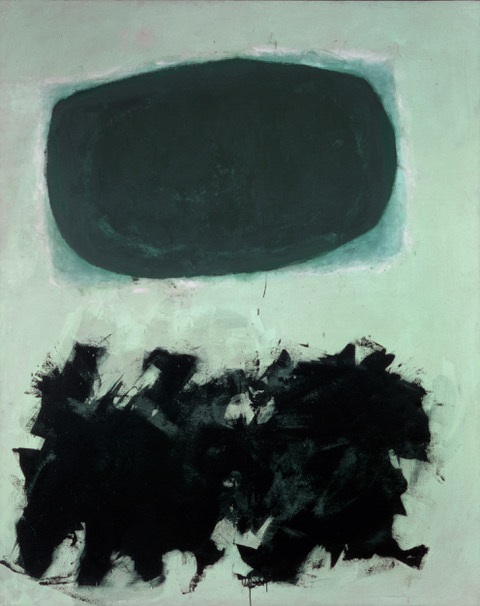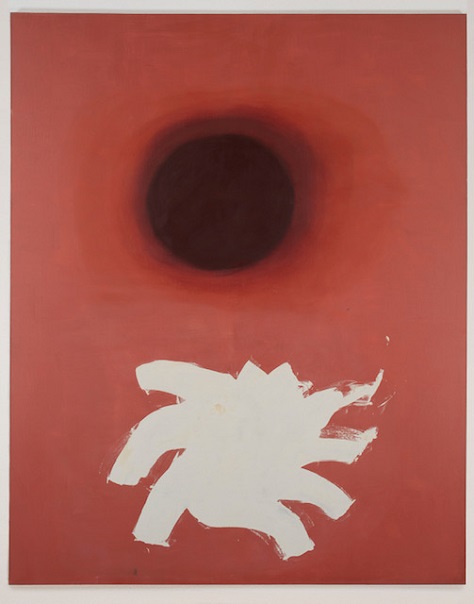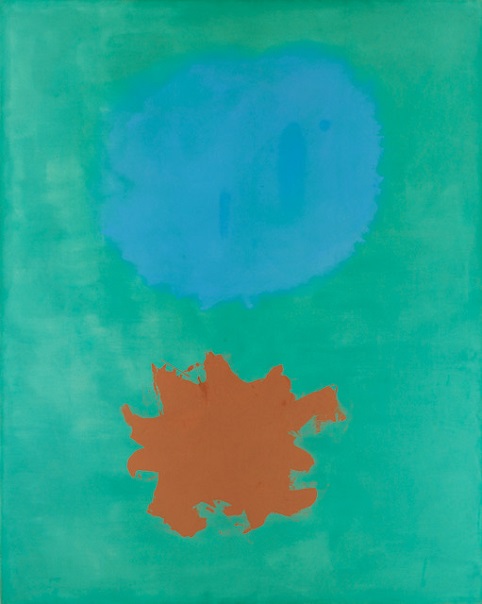For anyone who is captivated by Adolph Gottlieb's "Burst" paintings, "Adolph Gottlieb: Classic Paintings" affords the opportunity to see prime examples at Pace Gallery's Chelsea location at 510 West 25th Street. On view through April 13, 2019, Pace secured works from the Adolph & Esther Gottlieb Foundation (which Pace has represented since 2001) as well as significant work from major museums such as The Museum of Modern Art, Whitney Museum of American Art, Walker Art Center, Jewish Museum, Albright-Knox Gallery, Princeton University Art Museum and more.
"Adolph Gottlieb: Classic Paintings" allows visitors to witness the way the artist moves from horizontal to vertical formats and the subtle, or not so subtle, permutations accruing to his final style. This is a focused show revealing Gottlieb's paintings in the later part of his life by featuring the "Bursts" series in several modes and the "Imaginary Landscapes" series, which led up to them.
Gottlieb was a major figure in the New York School and a pioneer of Abstract Expressionism. He also became part of the East Hampton, NY art community during his latter years. He is instantly recognizable for the "Bursts": an atmospheric ground of luminous color, brightly pigmented disk glowing aloft, and below, a powerfully brushed expressive form, often black.
The show points to the origin of the now iconic "Bursts" by example of the "Imaginary Landscape" painting Groundscape, 1956. In this seven by twelve-foot painting, the bottom two-thirds is defined by a horizon line, below which is an all-over composition in dark ochre, grey, and black brush strokes, drips and stains, opaque or translucent. Above this mass, set in a bright band of white, are three ovals: one red, and two black. The arrangement bespeaks a celestial tranquility above and an earthy energy below.
Gottlieb's artistic progression was typical of an Abstract Expressionist: initial realist training followed by exposure to modernism, then surrealist automatism, rejection of regional or social realist subjects, and finally, the pursuit of his unique abstract vision arising from the subconscious. The horrors of the Second World War definitively turned these artists away from any literal depictions of the external world.
Gottlieb's disk or orb motif, whether planetary or not, arose from surrealist biomorphism. The brushy areas below, often with drips and splatters, exemplify Abstract Expressionist action painting. The color-field background suggests infinity, and hearkens to the next chapter in art. Whether the bursts are apocalyptic or ethereal is a topic for debate. We don't need to decide: they absorb us sufficiently into their own visual realm.
In the early "Burst" painting, Exclamation, 1958, the dominant form is more box-like than the artist's typical oval, and its color a deep viridian, intensely dark as the painterly black cluster below. These elements are bigger and closer to the canvas edge than they appear later.
.

"Exclamation" by Adolph Gottlieb, 1958. Oil on canvas, 90 x 72 inches (228.6 cm x 182.9 cm). No. 70638. ©Adolph and Esther Gottlieb Foundation / Licensed by ARS, NY, NY. Courtesy Pace Gallery.
.
Blue at Noon, 1955, the earlier of two "Imaginary Landscapes" shown, presents a cage-like pattern of black lines upon which are deployed fragmented letters plus a circle and an arrow. Chalky white and sinuous black lines weave in and out of this matrix. Partially hidden shapes emerge from the underlying blue background as if floating in transparent layers.
An inner gallery features three crisp "Burst" paintings wherein bold red and black forms are balanced in expansive white backgrounds. The striking contrast in figure ground relationship so established may challenge the elimination of this effect often presumed of Abstract Expressionism by its critics, but this paradox is a key element to Gottlieb's distinction.
The final room of "Burst" paintings demonstrates a wide range of emotional moods. The brushy lower shapes vary in contrast to the background, and sometimes become calligraphic as in Three Discs on Chrome Ground, 1969. Some disk shapes have a halo of lighter stained pigment as in Alarmed White, 1962.
.

"Three Discs on Chrome Ground" by Adolph Gottlieb, 1969. Oil and acrylic on canvas, 48 x 72 inches (121.9 cm by 182.9 cm). No 70647. ©Adolph and Esther Gottlieb Foundation / Licensed by ARS, NY, NY. Courtesy Pace Gallery.
.

"Alarmed White" by Adolph Gottlieb, 1962. Oil on canvas, 90 × 72 inches (228.6 cm × 182.9 cm), No. 70547. ©Adolph and Esther Gottlieb Foundation / Licensed by ARS, NY, NY. Courtesy Pace Gallery.
.
Among the most handsome of the "Blasts" is Expanding, 1962, painted in an aqueous palette of green and blue. These marine colors resonate with Gottlieb's love of sailing, so notable that his racing prowess merited a report in the East Hampton Star.
.

"Expanding" by Adolph Gottlieb, 1962. Oil on canvas, 90 x 72 inches (228.6 cm x 182.9 cm). No. 45871. ©Adolph and Esther Gottlieb Foundation / Licensed by ARS, NY, NY. Courtesy Pace Gallery.
.
Gottlieb spearheaded the 1950 artist protest against the Metropolitan Museum of Art's exclusion of contemporary art. He posed in Nina Leen's famous Life Magazine photo "The Irascibles" with such Hamptons regulars as Jackson Pollock, Willem de Kooning, James Brooks, Robert Motherwell and Hedda Sterne.
Gottlieb, closer in friendship to Mark Rothko and Milton Avery, then favored their preferred vacation haunt, Provincetown, MA, but by 1960 Gottlieb had bought his own house in East Hampton, NY on Apaquogue Road (not far from Grey Gardens). Dividing his time with a New York studio on the Bowery (and later, West Broadway in Soho), the artist commandeered a carriage house on his Hamptons property and turned it north so he could paint in natural light.
According to a 1960 postcard, now in the Smithsonian's Archives of American Art, Gottlieb began to enjoy his new home right away. Writing to artist friend Paul Bodin in a postcard dated July 13, 1960, Gottlieb penned, "Everything has worked out as well as expected. Good working studio, fine sailing and swimming.... This place is less hectic than Provincetown but far from dull."
However, as one of the few artists then living south of the highway, he had this to say about his neighbors and the value placed on the trappings of contemporary culture: "They respect me only because I'm successful in their terms," Gottlieb said, according to the New York Times. "They don't know my work, but they see I have a big house, beautiful grounds, two cars, a sailboat. These are the values that dominate American society."
Nonetheless, Gottlieb was comfortable making the 1970 poster "Guild Hall is for Everyone," employing one of his characteristic "Burst" images. The artist continued to spend much of his time in East Hampton, NY. Gottlieb died at 70 years old in 1974.
_____________________
BASIC FACTS: "Adolph Gottlieb: Classic Paintings" is on view March 1 to April 13, 2019 at Pace Gallery, 510 West 25 Street, New York, NY 10001. To see installation images of the show, click here. Gottlieb's art and the exhibition will be explored by a panel of experts at Pace Gallery on Monday, April 8, 2019 from 6 to 8 p.m. Free and open to the public. Space is limited. To RSVP, email [email protected].
Offered in collaboration with the Adolph & Esther Gottlieb Foundation, the panel will be moderated by art historian and critic Phyllis Tuchman, who has written several essays on Hamptons historic artists in conjunction with Guild Hall exhibitions. Panelists include Sanford Hirsch, Executive Director of the Adolph & Esther Gottlieb Foundation, Jeffrey Katzin, Dr. Kent Minturn and Karen Wilkin.
________________________
Franklin Hill Perrell is an art historian, curator, writer and a painter. A former Chief Curator at the Nassau County Museum of Art in Long Island and director of the Roslyn Landmarks Society, Perrell is a co-founder of Artful Circle, which offers educational programming, art tours and outsourced museum services.
________________________
Copyright 2019 Hamptons Art Hub LLC. All rights reserved.
